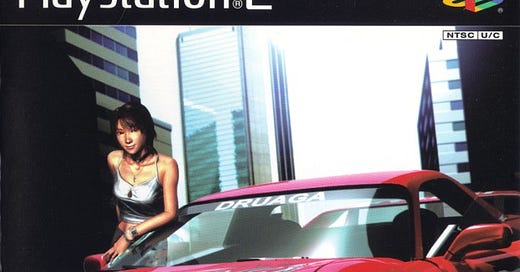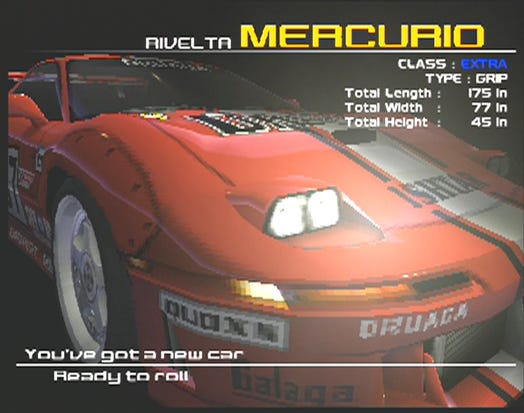Ridge Racer V or "The Future is Trapped in the Year 2000"
Drive fast, feel good
PUBLISHER/DEVELOPER: Namco
RELEASE DATE: Oct. 26, 2000
Ridge Racer V is a vibe, a mood, a feeling. Dusk-drenched streets. Intense breakbeats. A goofy, endearing announcer. Catching the perfect drift around a deadly corner while simultaneously passing your opponent. Like so many PS2 launch games, it evokes the misguided optimism that most of us had in the year 2000. This notion that, the future is here, humanity is in control, and the possibilities are limitless.
We know better now. A new millennium couldn't transport us into a better tomorrow anymore than it could wash away our sins. Similarly, Ridge Racer V immediately impresses with its shiny cars, loud youthful music, and excellent sense of speed.
A teenage boy cries in the streets, circa 2000, “As the PS2 is the future of gaming, so then is Ridge Racer V the future of racing games!” The boy is wrong. We are all wrong. Under the hood of this gorgeous game is not the complex V8 we want, but a souped-up four cylinder with little depth or substance.
Ridge Racer V contains the modes one expects – Design Your Car, Time Attack, Free Run, etc – but the game's meat (such as it is) lies in the Grand Prix. Each of the five Grand Prix challenges contains four races that you must beat, one after the other, in order to unlock the next Grand Prix.
RRV takes place within the creatively named and completely fictional Ridge City. The game boasts seven original courses, but in my play time, I only ever saw two unique courses that were then chopped and remixed with slightly different elements; a bridge moved here, an overpass tilted there. On the plus side, you will get used to every cranny and corner the city has to offer. The courses and remixes offered are well-designed, but the lack of variety suggests either a rushed development or dearth of ideas.
There are fourteen cars per Grand Prix race, and you must place no lower than fourth to move on to the next one. Fail to rank three times and you'll start at the beginning of the Grand Prix. Considering each Grand Prix has four races and the game only saves after you win each Grand Prix, failure to rank means you could get stuck on the same Grand Prix for hours on end.
Don't think this isn't possible. Despite Ridge Racer V's arcade sensibilities, the races are brutally difficult, even on Normal mode. If you don't have a good start where you pass most of the cars in the first lap, or if you find yourself hitting any boundaries or barriers within the race, good luck catching up to the high-ranking cars. I consider myself a racing game enthusiast, and I found it challenging to get past the first Grand Prix. I eventually switched the difficulty to Easy to see if this would alleviate the problem. Easy certainly made Ridge Racer V easier, to the point where I started placing first in every race and the game was no longer a challenge. Essentially, Easy is Very Easy and Normal is Hard.
If you decide to let the Normal difficulty have its way with you, choosing the right car is critical for progress. The Rivelta Mercurio was my preference, a flashy little number with excellent acceleration, handling, and tires that grip the road with ease. There are other cars with equally ridiculous names – Danver Toreador (the bull fighter of sports cars), Soldat Rumeur (like a rumor, but faster and more pretentious), and Kamata Fortune (ok then), to name three. All the cars have slightly different levels of acceleration, speed, and handling, but you can't fine tune them or upgrade any of their parts for better ones. This is still Ridge Racer, not Gran Turismo.
Ridge Racer V isn't the full-bodied racing vision the PS2 deserved around launch time, but it does effectively convey what Sony's new console could achieve. The game is a show off, a tease, a beautiful person who has little to say, yet you're fixated on every word.
And now, nearly 25 years after the PS2's launch, Ridge Racer V perfectly captures new millennium nostalgia. Drifting around sharp corners within Ridge City's limited framework while listening to Boom Boom Satellite's “Fogbound,” evokes both a simpler time and the future that never fully arrived. A beautiful place to visit, but I wouldn’t want to live there.










I'm with you, I miss Japanese arcade racers. Although I've heard Forza Horizon does the arcade racer part pretty well? I might be getting that wrong...
Yeah nothing beats playing Pole Position or OutRun (or Daytona USA, etc) in an arcade, the way they were originally intended to be played.
I feel like "quirkiness" in games in general, particularly Western games, has slowly declined in favor of overly serious characters and plots. Thank goodness we have decades of games with at least strange elements in them to return to if need be.
Thanks for the comment!
I miss the days when PlayStation consoles launched alongside a new Ridge Racer title…